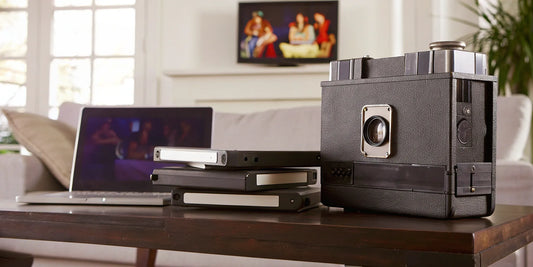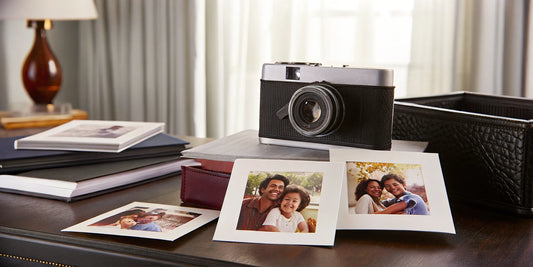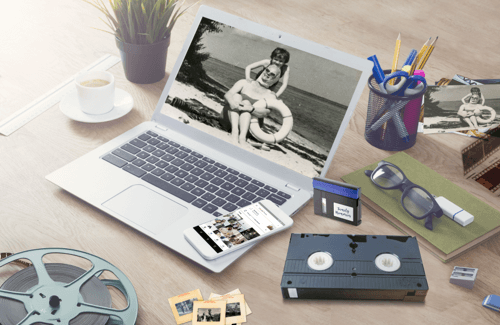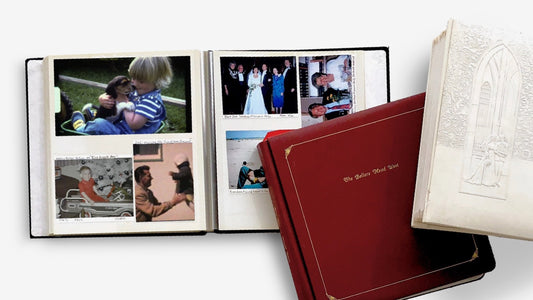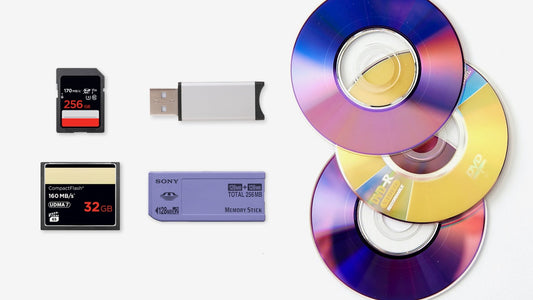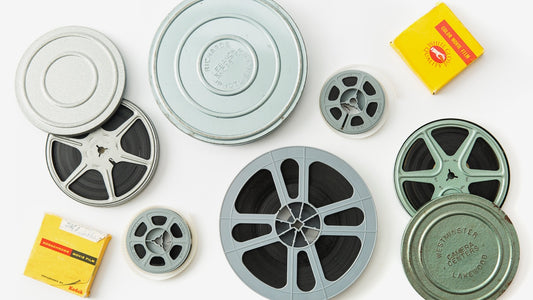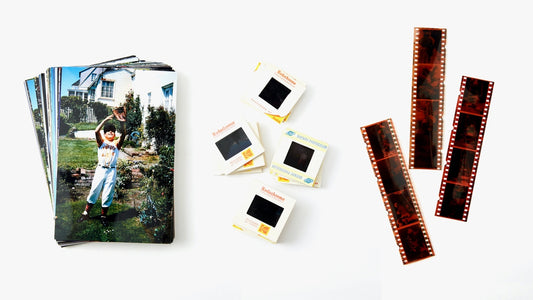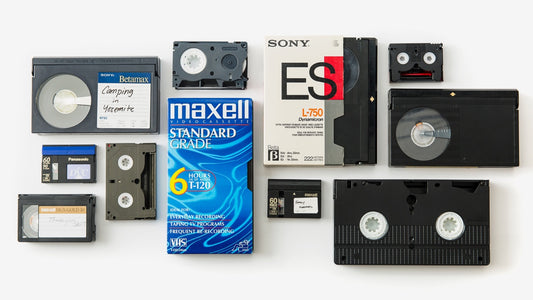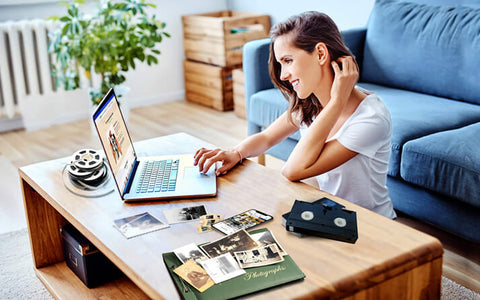The biggest threat to your family’s home movies isn’t a fire or a flood; it’s time. Those MiniDV tapes you’ve kept safe for years are on a countdown. The magnetic tape storing those memories wasn't made to last forever and can show serious decay in as little as a decade. Every year that passes makes it harder to recover those precious moments—a baby’s first steps, a grandparent’s laugh. Digitizing them is the only way to stop the clock. Whether you want to transfer MiniDV tapes to DVD or create digital files for sharing, acting now is key. We’ll walk you through everything you need to know to protect your family’s legacy.
Key Takeaways
- Act Now to Save Your Memories: MiniDV tapes weren't made to last forever, and the camcorders that play them are hard to find. Digitizing your collection is the best way to stop the clock on degradation and safeguard your family's home movies from being lost for good.
- Decide Between DIY and a Professional Service: A DIY project can be rewarding but requires the right gear, time, and technical patience. For guaranteed quality and peace of mind, a professional service handles all the work, ensuring your irreplaceable tapes are preserved safely and beautifully.
- Protect Your New Digital Library: Your preservation work isn't done once the tapes are digitized. Safeguard your files for the long term by creating multiple backups. A simple strategy is to keep one copy on your computer, another on an external hard drive, and a third in a cloud storage service.
What Are MiniDV Tapes & Why Should You Transfer Them?
If you were filming family events in the late ‘90s or early 2000s, you probably have a box of MiniDV tapes somewhere. These compact cassettes were a huge step up from bulky VHS camcorders, making it easier than ever to capture birthdays, holidays, and school plays. But finding a working camcorder to play them on today can be a real challenge. More importantly, the memories stored on those tapes are at risk of disappearing forever. Digitizing them is the only way to ensure they last for generations to come.
What Exactly Is a MiniDV Tape?
MiniDV tapes were the go-to format for consumer camcorders for a relatively short period, but they made a big impact. They recorded digital video onto magnetic tape, offering much better quality than their analog predecessors. However, technology moved on quickly, and these tapes, along with the cameras that played them, became obsolete. Now, many of us are left with stacks of these little tapes holding priceless home movies, with no easy way to watch them. This is the first major hurdle: accessing the memories you worked so hard to record.
Warning Signs: Is Your MiniDV Tape Damaged?
The biggest threat to your MiniDV tapes is time itself. The magnetic tape inside them is fragile and wasn't designed for long-term storage. Over time, this tape can degrade, leading to video and audio dropouts, color loss, and static. Environmental factors like heat and humidity can speed up this process. Experts estimate that magnetic tape can start to show significant data loss in as little as 10 years and may become completely unplayable after 20. Every year that passes puts those irreplaceable moments—like a baby’s first steps or a grandparent’s laugh—at greater risk of being lost for good.
The Lifespan of a MiniDV Tape
MiniDV tapes were a fantastic technology, but they were never meant to be a permanent archive. The real issue lies with the magnetic tape inside each cassette. This delicate material wasn't designed for long-term storage and naturally breaks down over time. Everyday environmental factors like heat and humidity can make things worse, causing the tape layers to stick together and leading to permanent damage when you try to play them. Even if you’ve stored your tapes in a cool, dry place, the clock is still ticking on the chemical stability of the tape itself, putting your video and audio quality at risk of fading away for good.
So, how much time do you really have? Most preservation experts agree that magnetic tape can show significant decay in as little as 10 to 20 years. This means that tapes filmed in the early 2000s are already well into the danger zone. With each passing year, the risk of video dropouts, color fading, and distorted audio grows, until the tape might not play at all. This isn't just a technical problem—it's about losing the irreplaceable sights and sounds of your family's history. The only way to truly protect these moments for the future is through a digital transfer, which creates a stable, lasting copy that won't degrade over time.
The Benefits of Digitizing Your MiniDV Tapes
Converting your MiniDV tapes to a digital format is about more than just being able to watch them again; it’s about preservation. Once your home movies are digitized, they are safe from physical decay. You can easily watch them on your computer, TV, or phone, and share them with family and friends with a simple click. A digital file doesn't wear out with each viewing. By choosing a professional video transfer service, you can stop the clock on degradation and give your family’s story a permanent, secure home. It’s the best way to protect your legacy and ensure your memories can be cherished for years to come.
Finding the Right Service to Transfer Your MiniDV Tapes
When you’re deciding on a service to handle your precious memories, it’s about more than just converting a tape. It’s about trust, quality, and making sure the process is as simple as possible. Choosing the right partner ensures your home movies are preserved safely and beautifully for generations to come.
How We Handle Your Tapes at YesVideo
When you’re ready to digitize your MiniDV tapes, you want a service that understands just how precious those memories are. At YesVideo, we specialize in handling a wide range of formats, from old film reels to your entire collection of MiniDV tapes. Our team takes care of all the technical work, so you don’t have to worry about finding the right cables or software. We provide a complete video transfer service that converts your tapes into high-quality digital files you can easily watch and share. Think of it as handing over your box of memories and getting back a timeless digital library, all handled with professional care right here in the USA.
Your Checklist for Choosing a Transfer Service
If you’re exploring different options, it’s important to know what sets a great service apart. Look for clear, upfront pricing so there are no surprises. Customer reviews are also your best friend—see what other families have said about their experience. A trustworthy service will have a transparent process and be clear about how they handle your original tapes. The best value isn’t always the lowest price; it’s the peace of mind that comes from a company that treats your memories with respect and delivers a beautiful digital product. Make sure they have clear guidelines for what makes a great digital image, ensuring every moment looks its best.
How Professionals Keep Your Tapes Safe
Handing over your one-of-a-kind tapes can feel nerve-wracking, which is why security should be a top priority. A reliable service will have a secure system for tracking your order from the moment it arrives to the moment it’s shipped back to you. At YesVideo, we process every order by hand, ensuring your tapes are treated with individual attention. We also use high-quality hardware and professional techniques for our film transfer and video digitization, which prevents the quality loss that can happen with DIY methods. This careful approach ensures your memories are not only safe but are also preserved in the best possible quality for you to enjoy for years to come.
What Makes a Transfer Service Great?
A great transfer service offers more than just a simple conversion. Look for features that make your life easier, like the ability to track your order’s progress online. The best services also give you flexible options for receiving your digitized memories. Whether you prefer DVDs, a USB drive, or the convenience of a digital download, you should be able to choose what works for you. Many services, including YesVideo, provide a private online account where you can view, download, and share your memories with family and friends anywhere in the world. This makes it simple to enjoy your newly preserved moments as soon as they’re ready.
What to Expect When You Send in Your Tapes
Sending your home movies off to be digitized can feel like a leap of faith. You’re trusting someone with irreplaceable memories. So, what actually happens behind the curtain after you’ve packed and shipped your MiniDV tapes? A professional service follows a meticulous, hands-on process designed to protect your tapes and create the best possible digital version of your memories. From the moment your package arrives, every step is handled with care by trained technicians who understand just how precious that footage is. Let’s walk through the journey your tapes take.
Step 1: Inspecting Your Tapes for a Safe Transfer
The moment your tapes arrive at the facility, they’re treated with the utmost care. Technicians don't just toss them onto a conveyor belt; they carefully unbox and inspect each tape by hand. They’re looking for any potential issues like a cracked casing, mold, or a snapped tape that might need repair before it can be played. This initial check-in is crucial because it ensures your tapes are in the best possible condition for transfer. Each order is barcoded and tracked, so you know exactly where your memories are at all times. This careful, hands-on approach is the first line of defense in preserving your footage safely.
Step 2: Capturing Your Footage in High Quality
Once inspected, your tapes move on to the main event: the transfer. Professionals use high-end, broadcast-quality decks—not the old camcorder you have in a closet. This specialized equipment is maintained and calibrated to capture the clearest picture and sound from your MiniDV tapes. Technicians monitor the entire video transfer process to handle any tracking issues or glitches that might pop up. They use high-quality hardware encoders to convert the analog signal to a digital one, which preserves the integrity of the original footage far better than most consumer-grade software. It’s this combination of expert oversight and professional-grade technology that produces a final product you’ll be proud to share.
Step 3: Selecting Your Digital Format
A key part of the professional process is getting your memories back in a format that works for you. Most services offer a choice between DVDs and digital files, and many people opt for both. DVDs are perfect for easy viewing on a TV and make wonderful gifts for family members. Digital files, typically delivered via a secure cloud account or on a USB drive, offer incredible flexibility. You can easily edit them, share clips on social media, or create multiple backups. With a service like YesVideo, you don’t have to worry about the technical details; they handle the conversion to modern formats that you can enjoy for years to come.
Step 4: Tracking Your Order from Start to Finish
Waiting for your memories to return can be nerve-wracking, which is why reputable services prioritize communication. From the moment your order is received, you’ll get email updates at every key stage: when your tapes arrive, when the transfer begins, and when your order ships back to you. Many services, including YesVideo, also provide a private online account where you can see your order’s progress. Once the digitization is complete, you can view, download, and share your memories right from your account, even before your original tapes and new digital copies have arrived back at your doorstep. This transparency gives you peace of mind throughout the entire process.
How Much Does It Cost and How Long Does It Take?
When you’re ready to digitize your home movies, two of the biggest questions are about cost and turnaround time. You want to know what to budget for and when you can expect to start reliving those precious moments. The answers depend on the service you choose, how many tapes you have, and any extra features you might want. Understanding the pricing structure and timeline upfront will help you find the right fit for your family’s needs and budget, ensuring there are no surprises along the way.
Let’s break down what you can typically expect when you send your MiniDV tapes to a professional service.
Breaking Down the Cost of Professional Transfers
The cost to transfer MiniDV tapes can vary, but most professional services charge on a per-tape basis. As a general benchmark, you might see prices starting around $30 to digitize a single tape. At YesVideo, our video transfer service is priced per tape, which includes the first two hours of footage. This straightforward approach makes it easy to calculate your total cost based on the number of tapes in your collection.
When comparing prices, be sure to check what’s included. Some companies charge extra for digital downloads or a DVD copy, so it’s important to read the fine print. A clear, all-inclusive price often provides the best value and saves you from unexpected fees later on.
How Pricing Is Calculated
Most professional services charge on a per-tape basis, which makes it simple to estimate your costs. You can generally expect prices to start around $30 for a single tape. At YesVideo, our video transfer service is priced per tape and includes the first two hours of footage, so you know exactly what you’re paying for. This straightforward approach helps you calculate the total cost just by counting the tapes in your collection. When you're comparing different options, make sure to look closely at what’s included in the price. Some companies add extra fees for digital downloads or a DVD copy, so a clear, all-inclusive price often provides the best value and protects you from surprise charges down the line.
Discounts for Large Orders
If you have a big box of tapes, you’re in luck. Many transfer services offer discounts for larger orders, meaning the more memories you preserve, the more you can save. The price per tape often decreases as your order size grows, making it more affordable to digitize your entire collection at once. This is a great incentive to gather all those tapes from closets, attics, and storage bins. You could even ask your parents or siblings if they have any tapes they’d like to add to the order. Consolidating everyone’s home movies into one large batch is a smart way to take advantage of bulk pricing and ensure no precious moments are left behind.
Are Optional Add-Ons Worth It?
While your main goal might be digitizing MiniDV tapes, you may have other memories stored on different formats. Many services offer a way to consolidate your entire collection at once. Think about those boxes of old photos, film reels, or photo albums sitting next to your tapes. Services like photo transfer can digitize your loose snapshots, while specialized album scanning keeps your curated photo books intact.
Bundling these services can be a convenient and cost-effective way to create a complete digital archive of your family’s history. Instead of just preserving your home movies, you can build a comprehensive library that tells a much richer story for generations to come.
Need It Fast? Rush Order Options
Digitizing memories is a delicate, hands-on process, so standard turnaround times usually take a few weeks. Each tape is carefully handled and processed by a technician to ensure the best quality. However, sometimes you need your memories back for a special occasion, like a milestone birthday, an anniversary celebration, or a family reunion.
If you’re on a tight deadline, look for a service that offers rush processing. Many professional companies, including YesVideo, provide expedited options that can significantly shorten the wait time. This is a fantastic feature if you’re planning a surprise gift or need your digitized videos ready for an upcoming event. It gives you the flexibility to meet your deadline without sacrificing quality.
Look for These Value-Added Services
A great transfer service does more than just convert your tapes. The real value often comes from how you can access and share your newly digitized memories. Many top-tier providers, including YesVideo, include a private online account with your order. This secure, cloud-based platform lets you view your videos from any device, anytime.
Instead of just receiving a DVD or a USB, you get a flexible, modern way to enjoy your memories. You can easily download the files to your computer, create custom clips, and share your favorite moments with family and friends through a simple link. This feature adds incredible value, transforming your old tapes into a living digital library that’s easy to access and enjoy.
Tape Repair and Handling
One of the biggest advantages of using a professional service is their ability to handle tapes that aren't in perfect condition. When your tapes arrive at a facility like YesVideo, they aren’t just thrown into a machine. Instead, trained technicians carefully inspect each one by hand. They look for common issues that could prevent a successful transfer, such as a cracked casing, mold, or a snapped tape. Many of these problems can be repaired on-site, saving a tape that might otherwise be unplayable. This careful, hands-on approach ensures your memories are treated with the respect they deserve and gives them the best possible chance of being fully preserved, even if they’ve seen better days.
Shipping and Digital Backup Guarantees
It’s completely normal to feel a little anxious about shipping your one-of-a-kind home movies. That’s why a trustworthy service prioritizes clear communication and security. From the moment your order is received, you should expect email updates at every key stage: when your tapes arrive, when the transfer begins, and when your order ships back to you. At YesVideo, we provide a secure online account where you can track your order’s progress. Once your digital media transfer is complete, your memories are safely backed up in your account, giving you instant access and peace of mind even before your original tapes are returned.
Video Quality Upgrades
You might wonder if a professional transfer really looks better than a DIY setup. The answer is a resounding yes. Professionals use high-end, broadcast-quality decks to play your MiniDV tapes, not an old camcorder from the back of a closet. This specialized equipment is meticulously maintained and calibrated to capture the clearest picture and sound possible from the magnetic tape. This technology can often pull a better-quality signal from a tape than consumer-grade players can, resulting in a sharper, more stable video. This commitment to quality hardware is a key part of a professional video transfer, ensuring your final digital files look as good as they possibly can.
How to Transfer MiniDV Tapes Yourself
If you’re feeling adventurous and have some tech know-how, transferring your MiniDV tapes at home can be a rewarding project. It gives you direct control over the process, but it requires the right equipment and a bit of patience. Before you start, know that this isn't a quick task—each tape needs to be captured in real-time, meaning a 90-minute tape will take 90 minutes to digitize. If you're ready to get started, here’s what you need to know. For those who decide the DIY route isn't for them, our video transfer service is always here to help you preserve those memories without the hassle.
Understanding the Technology: Digital vs. Analog Transfer
To get the best results from a DIY transfer, it helps to understand a little about the technology you're working with. Unlike older formats like VHS, which are analog, MiniDV tapes are digital. This is a crucial distinction because it changes the entire goal of the transfer process. With an analog tape, you’re converting a physical signal into a digital file, and some quality loss is almost inevitable. But with a digital tape, you’re not converting anything. You’re simply moving data from one place (the tape) to another (your computer). Understanding this difference is the first step to achieving a perfect, high-quality copy of your home movies.
Why MiniDV Tapes Are Already Digital
Here’s the most important thing to know: MiniDV tapes are already digital. The video and audio are stored on the magnetic tape as a series of ones and zeros, just like a file on your computer. This means you are not converting them from analog to digital; you are simply performing a data transfer. Your goal is to copy that digital information from the tape to your computer without any changes or loss of quality. Think of it like copying a document from a USB drive to your desktop—you expect an exact replica. This is great news because it means you can create a perfect, lossless copy of your original footage if you use the right tools.
FireWire: The Key to a Perfect Digital Copy
The best way to transfer MiniDV tapes is by using a FireWire connection, also known as IEEE 1394 or i.LINK. This is the port on your camcorder that allows for a direct digital data stream to a computer. Using FireWire is the only way to ensure a perfect, bit-for-bit copy of your footage, keeping the original digital quality of the video completely intact. Most modern computers don’t have a FireWire port, so you’ll likely need to buy a FireWire card to install in your desktop or find a FireWire-to-Thunderbolt adapter for a Mac. This connection is the secret ingredient that allows you to bypass any quality-degrading conversion process and get a true digital master of your memories.
The Gear You Need for a DIY Transfer
First, you’ll need to gather your gear. The most important piece of equipment is a working MiniDV camcorder or a dedicated tape deck that can play your tapes. For the best results, try to use the camera that originally recorded the footage. You'll also need a computer and a way to connect the two. This usually means a FireWire cable (also known as IEEE 1394 or i-Link), which provides a higher quality transfer than USB for this format. If your computer doesn’t have a FireWire port, you may need to buy an adapter or a special video capture card. Finally, you'll need video capture software to record the footage onto your computer. Programs like WinDV or Apple’s iMovie can work well for this.
Before You Begin: Checking Your Tape Format
Before you invest in any equipment, take a close look at the tapes themselves. While they might all look like MiniDV tapes, there are a few different formats, including the standard DVC, the professional-grade DVCAM, and high-definition HDV. Each format requires a compatible camcorder or deck for playback. A standard MiniDV player won’t be able to play an HDV tape, for example. Check the labels on your tapes and cassettes for any of these indicators. Confirming your tape format first will save you from buying the wrong equipment and ensure you can actually play the memories you’re trying to save. If this all sounds too technical, remember that a professional video transfer service handles all these compatibility issues for you.
Playback Devices: Camcorders and Decks
To play your MiniDV tapes, you'll need a device that can read them, which is often the biggest hurdle in a DIY project. The ideal choice is the original camcorder you used to record the footage, as it’s already calibrated to the tape. If that’s not an option, you’ll need to find a working MiniDV camcorder or a specialized playback deck. Keep in mind that there are different types of MiniDV tapes, like DVCAM or HDV, so you have to make sure your device is compatible with the specific format of your tapes. Finding a reliable, working player can involve searching on eBay or at specialty electronics stores, and it might take some time to find one in good condition.
Connecting to Modern Computers: Cables and Adapters
Once you have a player, the next step is connecting it to your computer. For the best quality, you’ll want to use a FireWire connection, also known as an i-Link or IEEE 1394 port. This method transfers the video as a pure digital signal, preserving its original quality without any loss. Most modern computers don’t have FireWire ports, so you’ll likely need an adapter. For a desktop PC, you can install a FireWire card relatively easily. For newer Macs, you’ll need a series of adapters, typically a FireWire to Thunderbolt adapter, which can be a bit more of an investment. This connection is key to avoiding quality loss during the transfer.
A Note on Lower-Quality USB Capture Devices
You might see cheap USB capture devices advertised as an easy solution, but it’s best to avoid them for MiniDV tapes. These devices work by converting the tape’s digital signal to an analog one, and then back to digital on your computer. This double conversion process degrades the video quality, resulting in a fuzzier picture and less vibrant colors. You’ll lose the crisp detail that made MiniDV so great in the first place. While it might seem like a simpler option, you’ll be sacrificing the very quality you’re trying to preserve. Sticking with a FireWire connection ensures you get a true, bit-for-bit digital copy of your original footage.
Your Step-by-Step DIY Transfer Guide
Once you have all your equipment, you can begin the transfer process. It’s a good idea to do a short test run first to make sure everything is working correctly.
- Connect the hardware. Use your FireWire or USB cable to connect your MiniDV camcorder to your computer.
- Set your camcorder. Turn on the camcorder and switch it to “VCR” or “VTR” mode. This tells the camera it will be used for playback, not recording.
- Prepare your tape. Insert the MiniDV tape you want to transfer into the camcorder.
- Open your software. Launch the video capture software on your computer.
- Cue the tape. In your software, find the “capture” or “import” function. Press play on your camcorder and you should see the video appear in the software window. Rewind the tape to the beginning.
- Start recording. Hit the “Record” button in your software, then press “Play” on your camcorder. The software will now record the video as the tape plays.
- Wait it out. Let the entire tape play through. Remember, this happens in real-time.
- Stop and save. Once the tape is finished, click “Stop” in your software. It will then process and save the video as a digital file on your computer. Be sure to check the file to ensure the video and audio transferred correctly.
How to Troubleshoot Common Problems
It’s common to run into a few snags during a DIY transfer. If your video quality looks poor or the audio is out of sync with the picture, the first thing to check is your connections. Make sure all cables are plugged in securely. Sometimes, audio sync issues can be fixed by adjusting the settings within your capture software. Compatibility problems between your camera, cables, and software can also cause glitches. If you’re getting an error message or the software isn’t recognizing your camcorder, double-check that all your components are designed to work together. A quick search online for your specific software and camera model can often lead to forums with helpful solutions from others who have faced the same issue.
How to Get the Best Quality at Home
The quality of your final digital video depends heavily on your equipment. As mentioned, using a FireWire cable is highly recommended because it offers a direct digital-to-digital transfer, which preserves the original quality of your MiniDV footage much better than a USB connection. The single most important factor, however, is the condition of your playback device. Using the original camcorder is ideal because it’s already calibrated to the tapes it recorded. If the tape heads on your camcorder are dirty or worn, it can result in a distorted or glitchy video. Cleaning the heads can sometimes help, but a damaged player will unfortunately produce a low-quality transfer, no matter how good your software is.
Professional Service vs. DIY: Which Is Right for You?
Deciding between digitizing your MiniDV tapes yourself or handing them over to a professional can feel like a big choice. On one hand, a DIY project can feel empowering, but on the other, you’re dealing with irreplaceable memories. Let's walk through the key factors—quality, cost, time, and risk—to help you figure out the best path for you and your family’s precious tapes. There’s no single right answer, but understanding the trade-offs will make the decision much clearer.
Pro vs. DIY: The Quality Difference
When it comes to the final product, professional services have a distinct advantage. Think of it this way: you could bake a birthday cake at home, or you could order one from a professional baker. Both are made with love, but the baker has the specialized equipment and experience to get it just right. Services like YesVideo are staffed by technicians who work with outdated media every day. They know how to get the best picture and sound from MiniDV tapes and can handle various formats, ensuring your memories look and sound as good as possible. A DIY transfer can work, but you might run into issues with color correction, audio syncing, or overall clarity that a professional video transfer service is equipped to solve.
Breaking Down the Costs
At first glance, the DIY route might seem like the most budget-friendly option. However, the costs can add up quickly. You’ll likely need to buy a MiniDV player if you don't have one, plus specific converters, cables, and potentially software to capture and edit the video. These individual purchases can easily exceed the cost of a professional service. With a service, you get a clear, upfront price. For example, YesVideo charges a flat rate per tape, which covers the entire process from start to finish. This approach turns a potentially complicated project with hidden costs into a simple, predictable investment in preserving your memories without any surprise expenses.
How Much Time Will It Take?
This is where you trade one kind of time for another. Using a professional service requires patience, as the turnaround is typically several weeks from the time they receive your tapes. However, your active involvement is minimal—you just pack the box and send it off. The DIY approach, on the other hand, requires a significant hands-on time commitment. You’ll need to set up the equipment, monitor each tape as it transfers in real-time (a one-hour tape takes one hour to capture), and then edit and organize the files. If you have a busy schedule or a large collection of tapes, the convenience of a professional service can be a huge relief.
What Are the Risks?
Handling old tapes always comes with a bit of risk. MiniDV tapes are more durable than formats like VHS, but they are still susceptible to damage, and the equipment needed to play them is aging. If you take the DIY route, you risk accidentally damaging a tape during playback or ending up with a low-quality transfer that doesn't do your memories justice. Professional services are built around mitigating these risks. They use well-maintained, professional-grade equipment and have established processes for handling delicate media. Entrusting your tapes to a company that specializes in digital media transfer provides peace of mind, knowing your memories are in safe hands and the final result will be a lasting digital keepsake.
Keeping Your Digital Memories Safe for Good
Getting your memories digitized is a huge step, but the journey to preserve them doesn’t end there. Now that you have these precious moments in a digital format, it’s important to create a plan to protect them for the long haul. Think of your new digital files like the original tapes and photos—they need proper care to ensure they last for generations. Physical items like DVDs can get scratched, and digital files can be accidentally deleted or lost if a hard drive fails.
The good news is that protecting your digital memories is easier than you think. It all comes down to a few simple habits: storing your physical media correctly, creating smart backups, and making sure your files remain accessible as technology changes. By taking a few extra steps now, you can feel confident that your family’s legacy is safe, secure, and ready to be shared for years to come. We’ll walk you through exactly how to do it.
Store Your DVDs the Right Way
If you opted for DVDs, you have a great physical backup that can hold up to two hours of video. But just like any disc, they need a little TLC. To prevent scratches, data loss, and warping, always store your DVDs upright in their original cases. Find a cool, dark, and dry place for them, away from direct sunlight or extreme temperature changes, like an attic or basement. A shelf in a closet or a media cabinet in your living room is a perfect spot. Proper storage ensures that when you want to pop in a DVD and take a trip down memory lane, it will play without a hitch.
Create Digital Backups (and Why You Should)
This is the single most important step you can take. Technology can be unpredictable—laptops get stolen, external hard drives fail, and accidents happen. That’s why having multiple copies of your files is non-negotiable. A great rule of thumb is the 3-2-1 backup strategy: keep at least three copies of your files, on two different types of media (like your computer and an external hard drive), with one copy stored off-site. An easy way to get an off-site backup is by using a cloud storage service like Google Drive, Dropbox, or Amazon Photos. This way, even if something happens at home, your memories are safely stored elsewhere.
Future-Proofing Your Digital Files
Have you ever found an old file on your computer that you couldn’t open because the software was outdated? That’s something we want to avoid with your memories. When you get a professional photo transfer, your images are typically saved as JPEGs, and videos as MP4s. These are universal file formats, meaning they are widely supported and likely to be accessible for a very long time. Periodically, it’s a good idea to check on your files. Open a few every year or so to make sure they’re still in good shape and not corrupted. Using a quality service from the start gives you the best foundation for long-term access.
Simple Tips for Long-Term Preservation
Keeping your memories safe for the future is an ongoing process, but it’s a simple one. First, always start with the highest quality transfer, especially if your original media is old or fragile. A professional film transfer service ensures your digital copies are the best they can be. Next, get organized. Create folders on your computer and give your files clear, descriptive names (e.g., "Smith Family Vacation - July 1998"). Finally, be prepared to migrate your files. As technology evolves, you may need to move your collection from an old hard drive to a new one or switch to a different cloud service. A little maintenance every few years goes a long way.
How to Decide: Pro Service or DIY?
Deciding between a professional service and a DIY project comes down to what matters most to you. There’s no single right answer, but by thinking through a few key factors, you can find the perfect path for preserving your MiniDV tapes. It’s about balancing your time, budget, technical skills, and how you want your final memories to look and feel. Let's walk through the four main things to consider so you can make a choice you feel confident about.
What Do You Really Need?
First, take a moment for an honest self-assessment. How comfortable are you with technology? If the idea of connecting old camcorders to computers and troubleshooting software makes you anxious, a DIY approach might create more stress than it's worth. Also, think about your time. Digitizing tapes isn't a quick weekend project, especially if you have a large collection. If your schedule is already packed, handing your tapes over to experts can be a huge relief. A professional video transfer service handles all the technical work, letting you focus on the fun part: reliving your memories.
How Important is Video Quality to You?
What do you want the final product to look like? While a DIY conversion can get the job done, professional services use specialized equipment that cleans, corrects, and captures your footage at a much higher quality. These are your family’s irreplaceable moments—first steps, weddings, holidays—and they deserve to be preserved clearly. If you want sharp, vibrant videos that look great on modern screens, investing in a professional service is your best bet. They have the tools and expertise to make your old tapes look their best, ensuring every detail is saved for you and future generations to enjoy.
What's Your Budget?
Budget is always a practical consideration. At first glance, the DIY route might seem like the cheapest option, but the costs can add up. You may need to buy a specific camcorder, cables, and conversion software, not to mention the value of your own time. When looking at professional services, think of it as an investment in your memories. Compare pricing, but also look at what’s included. Many services, like YesVideo, offer a complete package that includes a digital copy, online viewing options, and secure handling. This upfront cost often provides better value and peace of mind than a piecemeal DIY setup.
How Soon Do You Need Them?
How soon do you want to be able to watch your digitized videos? A DIY project is done on your own schedule, which can be a pro or a con. For some, it can drag on for months. If you have a specific deadline in mind, like an upcoming family reunion or anniversary, a professional service offers a clear and reliable timeline. Most companies provide an estimated completion date and even offer order tracking so you know exactly where your memories are in the process. Choosing a service that handles everything from photo transfer to film reels means you can get all your media digitized efficiently and predictably.
Related Articles
Frequently Asked Questions
What if my tapes are broken or have mold on them? Can they still be saved? It’s a common worry, but in many cases, the answer is yes. Professional services often have technicians who can perform minor repairs, like fixing a snapped tape or cleaning mold from the casing. During the initial inspection process, they will assess the condition of each tape. If a repair is needed, they can typically handle it before the transfer begins, giving you the best possible chance of recovering those memories.
Is it really safe to mail my only copies of these tapes? This is probably the biggest concern people have, and it’s completely understandable. Reputable professional services have built their entire process around this concern. They use robust tracking systems with barcodes to monitor your order from the moment it arrives until it’s safely shipped back to you. Your tapes are handled by hand, not by automated machines, which minimizes the risk of damage and ensures they get the individual attention they deserve.
I don't have a working camcorder. Is a professional service my only choice? For most people, yes. Finding a working MiniDV camcorder today can be difficult and expensive, and even if you find one, it might not be in the best condition to play your tapes clearly. A professional service is the most reliable solution because they use well-maintained, broadcast-quality decks designed specifically for high-quality playback. This saves you the headache and expense of hunting down obsolete equipment.
Should I get DVDs, a USB drive, or a digital download? This really comes down to how you plan to watch and share your memories. DVDs are fantastic for easy viewing on a TV and make great gifts for less tech-savvy family members. A USB drive is a portable physical backup. However, a digital download or cloud access offers the most flexibility. It allows you to easily save the files to multiple devices, share them online with a simple link, and create your own backups, ensuring your memories are safe and accessible for years to come.
How is the quality from a professional service different from what I can do at home? The difference often comes down to the equipment. While a DIY setup can capture the footage, professional services use high-end decks and hardware that capture a much cleaner and more stable signal than a consumer camcorder. Technicians also monitor the transfer in real-time to adjust for any tracking issues. This results in a final video with better color, clearer audio, and fewer glitches than you could typically achieve on your own.


